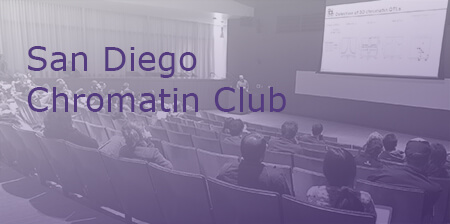<< Back to MOTIFvations Blog Home Page
The San Diego Chromatin Club is Bringing Local Epigenetics Experts Together

January 30, 2019
The Active Motif team prides ourselves on being a part of the epigenetics community, rather than just being a company that offers industry-leading products, antibodies, and epigenetic services. This commitment to epigenetics research includes sponsoring both international and local events aimed at bringing researchers together to talk science and interact outside of the lab.
For example, Active Motif is honored to be the official sponsor of the San Diego Chromatin Club. The San Diego Chromatin Club is a seminar series organized by scientific leaders Bing Ren, Ani Deshpande, Chris Benner, and Diana Hargreaves, and is attended by more than 100 investigators in the San Diego area working on chromatin biology, epigenetic mechanisms, and other related fields of research.
The most recent Chromatin Club meeting was on January 22, 2019 and featured amazing presentations by Dr. Luca Caputo and Dr. David Gorkin.
A Role for MyoD in Regulating Chromatin Structure and Cellular Differentiation
Dr. Luca Caputo is a postdoctoral research fellow in the lab of Dr. Pier Lorenzo Puri at Sanford Burnham Prebys, where he investigates the molecular mechanisms of myogenesis. Specifically, he studies the transcription factor MyoD and its role in the differentiation of fibroblasts to myotubes.
Dr. Caputo has used ChIP-Seq to demonstrate that only 10% of the loci occupied by MyoD are promoters of target genes, suggesting a DNA-binding role for MyoD in addition to transcriptional activation. He next used Hi-C analysis to show that MyoD overexpression accounts for about half of the three-dimensional genome structure alterations that occur following myotube differentiation.
MyoD was also shown to bind to insulated neighborhood loops and colocalizes with CTCF. Dr. Caputo shows that these MyoD-dependent loops form before MyoD target genes are expressed, implicating a direct role for MyoD in forming these loops. Interestingly, these myotube-specific structures and CTCF binding are not maintained when MyoD expression is turned off.
In summary, Dr. Caputo presents evidence that a single transcription factor, MyoD, is necessary and sufficient for differentiation of fibroblasts to myotubes and performs this largely by directly altering chromatin structure.
New Bioinformatics Approaches to Analyze Chromatin Structural Variation
Dr. David Gorkin is the Associate Director of Epigenomics at the UCSD Center for Epigenomics, and he is investigating variations in the three-dimensional structure of the genome, specifically in B-lymphoblast cell lines. The 3-D structure of the genome is largely cell-type specific, but inter-individual variation also exists. Dr. Gorkin studies whether these variations, sometimes in the form of single-nucleotide polymorphisms (SNPs), are associated with disease risk.
To improve measurement of structural variation, as measured by Hi-C and ChIP-Seq for specific histone modifications, Dr. Gorkin defined four bioinformatics metrics: a directionality index, an insulation score, a measure of frequently interacting regions (FIRE score), and a measure of A vs B compartmentalization, in which “A” regions are gene- and regulatory-rich and “B” regions are gene deserts.
Preliminary findings show that specific SNPs do lead to variation in 3-D structure of chromatin and that the epigenetic marks at those variable loci also correlate with the variation. For example, SNPs in consensus binding sites for the insulator protein CTCF can make the difference between a strong or weak CTCF binding. In turn, the loop structures resulting from CTCF binding are either strong or weak loops as measured by Hi-C.
The overall goal of this work is to detect and define quantitative trait loci (QTLs) by Hi-C that indicate the phenotype of the cell. In the future, techniques like Hi-C may be used to identify structural variations in the genome in clinical settings, and thus may become valuable biomarkers.
Chromatin Clubs Show That Teamwork Accelerates Scientific Discovery
They say that teamwork makes the dream work, and that’s definitely the case in scientific research. While there will always be some level of competition due to limited funding availability and the drive to publish groundbreaking discoveries first, the biggest scientific discoveries often include contributions from several different research groups, each with their own areas of specialization.
Research technologies have changed and improved quite a bit over the years and some labs have areas of strength that can complement other labs with different strengths. When labs work together, the scientific questions that can be answered are much greater than the sum of their parts.
It is great to see open forums like the San Diego Chromatin Club where researchers share ideas with each other and offer suggestions to help improve their results, with the ultimate goal of improving health and medicine. Sometimes the best discussions are had over a beer, and Active Motif is proud to be sponsoring and promoting these conversations.
<< Back to MOTIFvations Blog Home Page





